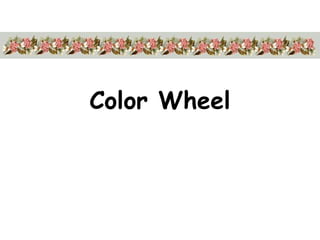
ColorWheel.ppt
- 1. Color Wheel
- 2. COLOR IS THE REFLECTION OF LIGHT FROM A PIGMENTED SURFACE. COLOR IS THE PERSONALITY OF A DESIGN.
- 3. The Color Wheel • The color wheel is divided into three categories: primary, secondary, and tertiary. • The three primary colors are red, yellow and blue. • These colors are considered to be foundation colors because they are used to create all other colors.
- 4. Color Wheel • By combining two of the primary colors, three secondary colors are formed. They are orange, green and violet. • The six tertiary colors are made by combining a primary and an adjacent secondary color. These colors are red- orange, red-violet, yellow-green, yellow- orange, blue-green and blue-violet.
- 5. Color Wheel
- 6. Cool and Warm Colors • Colors are also divided into cool and warm categories. Warm colors are red, orange and yellow. The cool colors are green, blue and violet.
- 7. Color Terms • Color Harmony: using colors in a pleasing way. • Color Scheme: the make up of colors • Hue: color, any color • Intensity: the brightness and dullness of a color • Value: the lightness or darkness of a color.
- 8. Value • A tint of a color is made by adding white. • A shade is made by adding black. • Toning is made by adding gray.
- 9. Color Schemes • Monochromatic - This color scheme uses a single hue. (example: red and its varying tints and shades) • Accented Neutral – using tint, tone and shade of a single hue with a neutral background. • The above 2 schemes in to go into a room that is “busy” • Analogous - This scheme uses adjacent hues. (example: red, red-orange, and red-violet)
- 10. Complementary Colors • If two hues are opposite each other on the color wheel they are considered to be complementary colors. • When used together in a design they make each other seem brighter and more intense. (example: red and green) Mixed together makes brown
- 11. Split Complementary • This color scheme uses three colors: any hue and the two adjacent to its complement. (example: red, yellow-green, and blue-green)
- 12. Triadic • This scheme also uses three colors. They are evenly spaced from each other. (example: red, yellow, and blue)
- 13. Double Complement • Made of colors that are adjacent to both direct complements. (example: yellow and violet, blue and orange)
- 14. Tetrad • This scheme uses four colors evenly spaced on the color wheel. • A primary, secondary and two tertiary colors are used. (example: red, green, yellow-orange, and blue-violet)
- 15. Polychromatic • Use any 4 or more colors from the colors wheel.